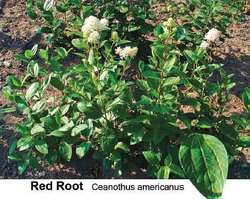red root
Recognized by showy round puffy clusters of white flowers. Pointy oval leaves make tea used as substitute for imported tea with no caffeine, as well as for stomach, lung, blood cleaner, laxative. Root is astringent, expectorant, used for asthma, bronchitis, coughs, spleen, dysentery, hemorrhoids. Strong astringent (stops bleeding) bark tea used externally for venereal sores. Nitrogen fixer. Flowers rich in saponins to make lathering shampoo and soap (won’t remove oils though). Wet flowers can be simply rubbed on body.
Edible Plant Guide © 2012 Markus Rothkranz
